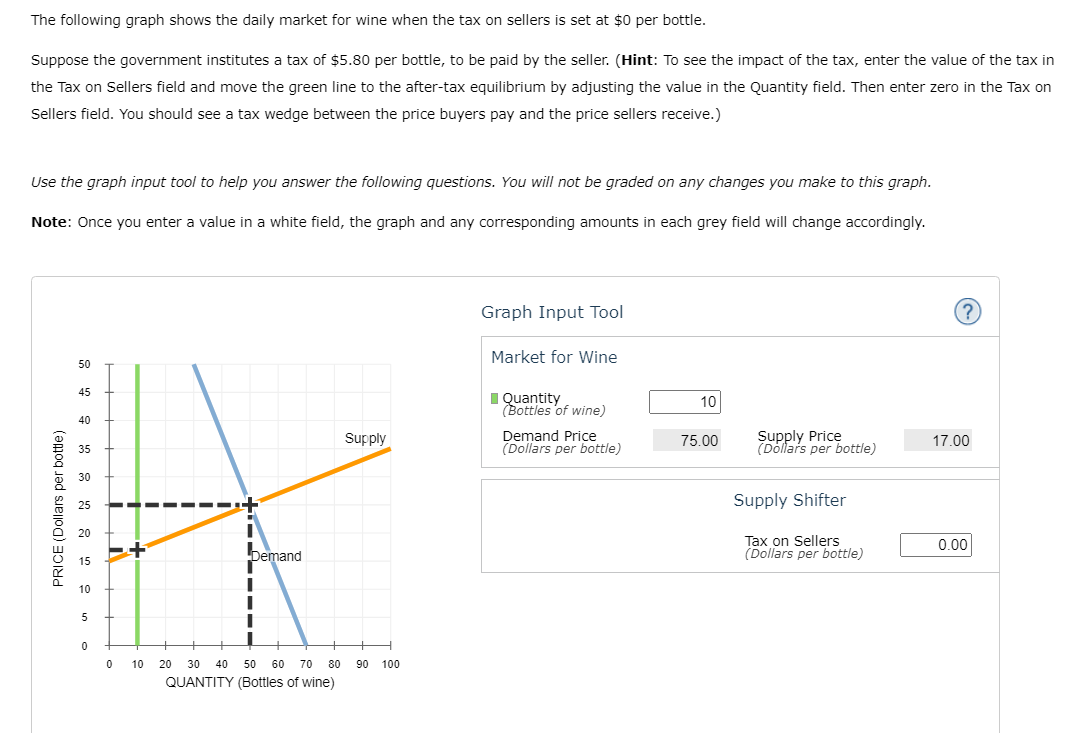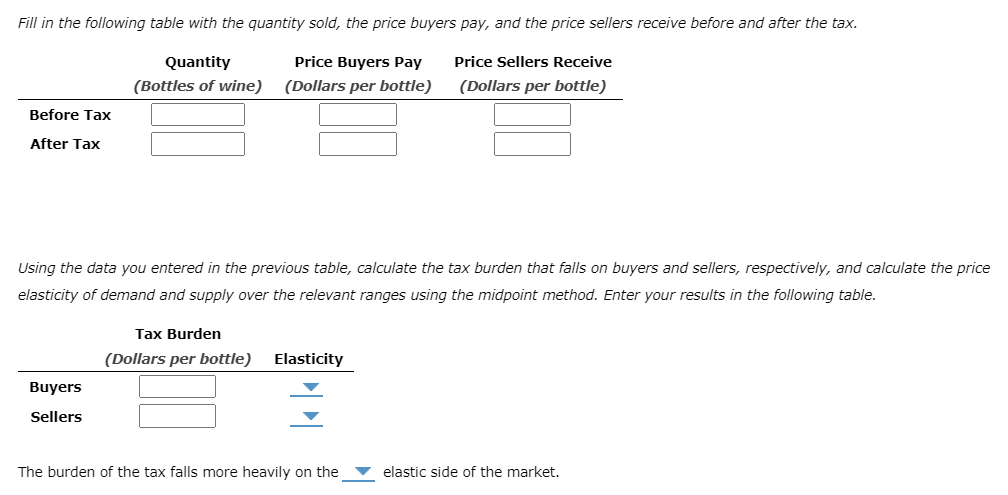The following graph shows the daily market for wine when the tax on sellers is set at $0 per bottle. Suppose the government institutes a tax of $5.80 per bottle, to be paid by the seller. (Hint: To see the impact of the tax, enter the value of the tax in the Tax on Sellers field and move the green line to the after-tax equilibrium by adjusting the value in the Quantity field. Then enter zero in the Tax on Sellers field. You should see a tax wedge between the price buyers pay and the price sellers receive.) Use the graph input tool to help you answer the following questions. You will not be graded on any changes you make to this graph. Note: Once you enter a value in a white field, the graph and any corresponding amounts in each grey field will change accordingly. 50 45 40 Graph Input Tool Market for Wine Quantity (Bottles of wine) 10
The following graph shows the daily market for wine when the tax on sellers is set at $0 per bottle. Suppose the government institutes a tax of $5.80 per bottle, to be paid by the seller. (Hint: To see the impact of the tax, enter the value of the tax in the Tax on Sellers field and move the green line to the after-tax equilibrium by adjusting the value in the Quantity field. Then enter zero in the Tax on Sellers field. You should see a tax wedge between the price buyers pay and the price sellers receive.) Use the graph input tool to help you answer the following questions. You will not be graded on any changes you make to this graph. Note: Once you enter a value in a white field, the graph and any corresponding amounts in each grey field will change accordingly. 50 45 40 Graph Input Tool Market for Wine Quantity (Bottles of wine) 10
Principles of Microeconomics (MindTap Course List)
8th Edition
ISBN:9781305971493
Author:N. Gregory Mankiw
Publisher:N. Gregory Mankiw
Chapter8: Application: The Cost Of Taxation
Section: Chapter Questions
Problem 10PA
Related questions
Question

Transcribed Image Text:The following graph shows the daily market for wine when the tax on sellers is set at $0 per bottle.
Suppose the government institutes a tax of $5.80 per bottle, to be paid by the seller. (Hint: To see the impact of the tax, enter the value of the tax in
the Tax on Sellers field and move the green line to the after-tax equilibrium by adjusting the value in the Quantity field. Then enter zero in the Tax on
Sellers field. You should see a tax wedge between the price buyers pay and the price sellers receive.)
Use the graph input tool to help you answer the following questions. You will not be graded on any changes you make to this graph.
Note: Once you enter a value in a white field, the graph and any corresponding amounts in each grey field will change accordingly.
PRICE (Dollars per bottle)
50
45
40
35
5
0
0
10
Demand
80
20 30 40 50 60 70
QUANTITY (Bottles of wine)
Supply
90 100
Graph Input Tool
Market for Wine
Quantity
(Bottles of wine)
Demand Price
(Dollars per bottle)
10
75.00
Supply Price
(Dollars per bottle)
Supply Shifter
Tax on Sellers
(Dollars per bottle)
17.00
0.00

Transcribed Image Text:Fill in the following table with the quantity sold, the price buyers pay, and the price sellers receive before and after the tax.
Quantity
Price Buyers Pay Price Sellers Receive
(Bottles of wine) (Dollars per bottle) (Dollars per bottle)
Before Tax
After Tax
Using the data you entered in the previous table, calculate the tax burden that falls on buyers and sellers, respectively, and calculate the price
elasticity of demand and supply over the relevant ranges using the midpoint method. Enter your results in the following table.
Buyers
Sellers
Tax Burden
(Dollars per bottle) Elasticity
The burden of the tax falls more heavily on the
elastic side of the market.
Expert Solution
Step 1
Demand refers to the amount of a certain good or service that consumers are willing and able to purchase at a given price.
Supply refers to the amount of a certain good or service that producers are willing and able to produce and sell at a given price.
Trending now
This is a popular solution!
Step by step
Solved in 2 steps with 2 images

Knowledge Booster
Learn more about
Need a deep-dive on the concept behind this application? Look no further. Learn more about this topic, economics and related others by exploring similar questions and additional content below.Recommended textbooks for you

Principles of Microeconomics (MindTap Course List)
Economics
ISBN:
9781305971493
Author:
N. Gregory Mankiw
Publisher:
Cengage Learning

Principles of Macroeconomics (MindTap Course List)
Economics
ISBN:
9781285165912
Author:
N. Gregory Mankiw
Publisher:
Cengage Learning

Essentials of Economics (MindTap Course List)
Economics
ISBN:
9781337091992
Author:
N. Gregory Mankiw
Publisher:
Cengage Learning

Principles of Microeconomics (MindTap Course List)
Economics
ISBN:
9781305971493
Author:
N. Gregory Mankiw
Publisher:
Cengage Learning

Principles of Macroeconomics (MindTap Course List)
Economics
ISBN:
9781285165912
Author:
N. Gregory Mankiw
Publisher:
Cengage Learning

Essentials of Economics (MindTap Course List)
Economics
ISBN:
9781337091992
Author:
N. Gregory Mankiw
Publisher:
Cengage Learning

Principles of Macroeconomics (MindTap Course List)
Economics
ISBN:
9781305971509
Author:
N. Gregory Mankiw
Publisher:
Cengage Learning